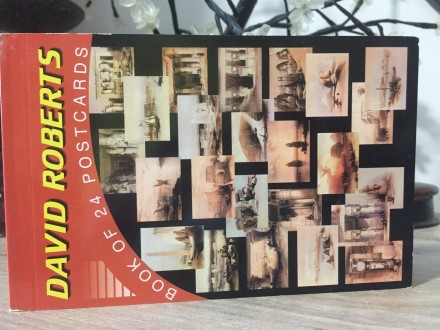David Roberts BOOK OF 24 POSTCARDS / Egipat
| Cena: |
| Želi ovaj predmet: | 5 |
| Stanje: | Polovan bez oštećenja |
| Garancija: | Ne |
| Isporuka: | BEX Pošta DExpress Post Express Lično preuzimanje |
| Plaćanje: | Tekući račun (pre slanja) Ostalo (pre slanja) Pouzećem Lično |
| Grad: |
Novi Sad, Novi Sad |
Godina izdanja: Ostalo
ISBN: Ostalo
Jezik: Engleski
Oblast: Slikarstvo
Autor: Strani
Odlično očuvano
Retko u ponudi
David Roberts RA RBA (24 October 1796 – 25 November 1864) was a Scottish painter. He is especially known for The Holy Land, Syria, Idumea, Arabia, Egypt, and Nubia, a prolific series of detailed lithograph prints of Egypt and the Near East that he produced from sketches he made during long tours of the region (1838–40). These and his large oil paintings of similar subjects made him a prominent Orientalist painter. He was elected as a Royal Academician in 1841.
David Roberts
David Roberts (1844).jpg
David Roberts in 1844 by Hill & Adamson
Born
24 October 1796
Stockbridge near Edinburgh, Scotland
Died
25 November 1864 (aged 68)
London, England
Nationality
Scottish
Movement
Orientalism
Elected
Royal Academician
Early life
Move to London
Edit
Roberts in 1842
In 1822 the Coburg Theatre, now the Old Vic in London, offered Roberts a job as a scenic designer and stage painter. He sailed from Leith with his wife and their six-month-old Christine and settled in London.[14] After working for a while at the Coburg Theatre, Roberts moved to the Theatre Royal, Drury Lane to create dioramas and panoramas with Stanfield.[15]
A miniature by Roberts from this time shows Margaret as a delicate woman with blonde ringlets, holding the smiling three-year-old Christine. But Roberts` family life was not as idyllic as this picture suggests: Margaret had become an alcoholic, and eventually, in 1831, Roberts sent her back to Scotland to be cared for by friends. Roberts may have burned some letters from this period in shame at his wife`s drinking problem, but he was unusually frank in a letter to a friend, David Ramsay Hay. Roberts and Hay had been an apprentices together, and Hay had been seeing a mistress since his own wife had started drinking.
`If you do not know our cases are almost parallel. Yours is not as bad as mine, having some consolation. The state of my nerves is such I can scarcely write. But thank God she leaves tomorrow—I hope for ever.`[14]
In 1824, he exhibited another view of Dryburgh Abbey at the British Institution and sent two works to the first exhibition of the newly formed Society of British Artists. In the autumn of 1824 he visited Normandy. His paintings based on this trip began to lay the foundation of his reputation; one of them, a view of Rouen Cathedral, sold for 80 guineas.[13]
While he built his reputation as a fine artist, Roberts`s stage work had also been commercially successful. Commissions from Covent Garden included the sets for the London premiere of Mozart`s Die Entführung aus dem Serail (The Abduction from the Seraglio) in 1827, scenery for a pantomime depicting the naval victory of Navarino, and two panoramas that he executed jointly with Stanfield.[13]
During the second part of the 1820s, and in addition to English and Scottish scenes, Roberts painted views of prominent buildings in France and the Low Countries including Amiens, Caen, Dieppe, Rouen, Antwerp, Brussels and Ghent, sometimes making several paintings of the same scene with only minor variations.[16]
By 1829 he was working full-time as a fine artist. That year, he exhibited the Departure of the Israelites from Egypt, in which his style first became apparent.[13] In 1831, the Society of British Artists elected him as their president.
Travel to Spain
Travel to Egypt and the Holy Land
Edit
Isle of Graia Gulf of Akabah Arabia Petraea, 1839 lithograph of a trade caravan by Louis Haghe from an original by David Roberts.
Main article: The Holy Land, Syria, Idumea, Arabia, Egypt, and Nubia
J. M. W. Turner persuaded Roberts to abandon scene painting and devote himself to becoming a full-time artist. Roberts set sail for Egypt on 31 August 1838, a few years after Owen Jones. His intent was to produce drawings that he could later use as the basis for the paintings and lithographs to sell to the public. Egypt was much in vogue at this time, and travellers, collectors and lovers of antiquities were keen to buy works inspired by the East or depicting the great monuments of ancient Egypt.
Roberts made a long tour in Egypt, Nubia, the Sinai, the Holy Land, Jordan and Lebanon. Throughout, he produced a vast collection of drawings and watercolour sketches.
Muhammad Ali Pasha received Roberts in Alexandria on 16 May 1839, shortly before his return to the UK. He later reproduced this scene, apparently from memory, in Volume 3 of Egypt & Nubia.
Return to Britain
Later life
Selected works
Edit
Paintings
Edit
Departure of the Israelites (1829)
The Great Staircase, Stafford House (1832), UK Government Art Collection[19]
Interior of Seville Cathedral (1834)
A View in Cairo (1840), The Royal Collection, Windsor Castle
The Temple at Dendera (1841)
The Gateway to the Great Temple at Baalbec (1841)
Ruins of the Great Temple at Karnak, in Upper Egypt (1845)[20]
The Destruction of Jerusalem (1850)
The Church of the Jesuits, View on the Grand Canal, Venice (1854), Yale Center for British Art, Paul Mellon Collection, New Haven, Connecticut
Edinburgh from the Calton Hill (1858)
The Dogana and Santa Maria, Venice (1862) Sheffield Galleries & Museums Trust
Street in Cairo (Royal Holloway Collection, University of London)
Pilgrimage to Jerusalem (Royal Holloway Collection, London)
Prints
Edit
Picturesque Sketches in Spain (London, 1835–36)
The Holy Land, Syria, Idumea, Arabia, Egypt, and Nubia (London 1842–49, originally as The Holy Land, Syria, Idumea and Arabia and Egypt and Nubia, in 2x3 volumes.) Link to Images
Cities of North Africa (London 1852)
Journals
Edit
Roberts, David, Record Book, 1829–1864, unpublished manuscript, Yale Center for British Art, New Haven.
Roberts, David, Eastern Journal, 1838–1839, unpublished manuscript, National Library of Scotland, Edinburgh.
Tags:
Razglednice
Slikarstvo
Putovanja
Slike iz Egipta
Drevni Egipat
International shipping
Paypal only
(Države Balkana: Uplata može i preko pošte ili Western Union-a)
1 euro = 117.5 din
For international buyers please see instructions below:
To buy an item: Click on the red button KUPI ODMAH
Količina: 1 / Isporuka: Pošta / Plaćanje: Tekući račun
To confirm the purchase click on the orange button: Potvrdi kupovinu (After that we will send our paypal details)
To message us for more information: Click on the blue button POŠALJI PORUKU
To see overview of all our items: Click on Svi predmeti člana
Ako je aktivirana opcija besplatna dostava, ona se odnosi samo na slanje kao preporučena tiskovina ili cc paket na teritoriji Srbije.
Poštarina za knjige je u proseku 225 dinara, u slučaju da izaberete opciju plaćanje pre slanja i slanje preko pošte. CC paket je 340 dinara. Postexpress i kurirske službe su skuplje ali imaju opciju plaćanja pouzećem. Ako nije stavljena opcija da je moguće slanje i nekom drugom kurirskom službom pored postexpressa, slobodno kupite knjigu pa nam u poruci napišite koja kurirska služba vam odgovara.
Ukoliko još uvek nemate bar 10 pozitivnih ocena, ili imate negativnih ocena, zbog nekoliko neprijatnih iskustava, molili bi vas da nam uplatite cenu kupljenog predmeta unapred.
Novi Sad lično preuzimanje (pored Kulturne stanice Eđšeg) ili svaki dan ili jednom nedeljno zavisno od lokacije prodatog predmeta (jedan deo predmeta je u Novom Sadu, drugi u kući van grada).
Našu kompletnu ponudu možete videti preko linka
https://www.kupindo.com/Clan/H.C.E/SpisakPredmeta
Ukoliko tražite još neki naslov koji ne možete da nađete pošaljite nam poruku možda ga imamo u magacinu.
Pogledajte i našu ponudu na limundu https://www.limundo.com/Clan/H.C.E/SpisakAukcija
Slobodno pitajte šta vas zanima preko poruka. Preuzimanje moguce u Novom Sadu i Sremskoj Mitrovici uz prethodni dogovor. (Većina knjiga je u Sremskoj Mitrovici, manji broj u Novom Sadu, tako da se najavite nekoliko dana ranije u slucaju ličnog preuzimanja, da bi knjige bile donete, a ako Vam hitno treba neka knjiga za danas ili sutra, obavezno proverite prvo preko poruke da li je u magacinu da ne bi doslo do neprijatnosti). U krajnjem slučaju mogu biti poslate i poštom u Novi Sad i stižu za jedan dan.
U Novom Sadu lično preuzimanje na Grbavici na našoj adresi ili u okolini po dogovoru. Dostava na kućnu adresu u Novom Sadu putem kurira 350 dinara.
Slanje nakon uplate na račun u Erste banci (ukoliko ne želite da plaćate po preuzimanju). Poštarina za jednu knjigu, zavisno od njene težine (do 2 kg), može biti od 170-264 din. Slanje vise knjiga u paketu težem od 2 kg 340-450 din. Za cene postexpressa ili drugih službi se možete informisati na njihovim sajtovima.
http://www.postexpress.rs/struktura/lat/cenovnik/cenovnik-unutrasnji-saobracaj.asp
INOSTRANSTVO: Šaljem po dogovoru, ili po vašim prijateljima/rodbini ili poštom. U Beč idem jednom godišnje pa ako se podudare termini knjige mogu doneti lično. Skuplje pakete mogu poslati i po nekom autobusu, molim vas ne tražite mi da šaljem autobusima knjige manje vrednosti jer mi odlazak na autobusku stanicu i čekanje prevoza pravi veći problem nego što bi koštala poštarina za slanje kao mali paket preko pošte.
Ukoliko kupujete više od jedne knjige javite se porukom možda Vam mogu dati određeni popust na neke naslove.
Sve knjige su detaljno uslikane, ako Vas još nešto interesuje slobodno pitajte porukom. Reklamacije primamo samo ukoliko nam prvo pošaljete knjigu nazad da vidim u čemu je problem pa nakon toga vraćamo novac. Jednom smo prevareni od strane člana koji nam je vratio potpuno drugu knjigu od one koju smo mu mi poslali, tako da više ne vraćamo novac pre nego što vidimo da li se radi o našoj knjizi.
Ukoliko Vam neka pošiljka ne stigne za dva ili tri dana, odmah nas kontaktirajte za broj pošiljke kako bi videli u čemu je problem. Ne čekajte da prođe više vremena, pogotovo ako ste iz inostranstva, jer nakon određenog vremena pošiljke se vraćaju pošiljaocu, tako da bi morali da platimo troškove povratka i ponovnog slanja. Potvrde o slanju čuvamo do 10 dana. U 99% slučajeva sve prolazi glatko, ali nikad se ne zna.
Ukoliko uvažimo vašu reklamaciju ne snosimo troškove poštarine, osim kada je očigledno naša greška u pitanju.
Predmet: 71588049











